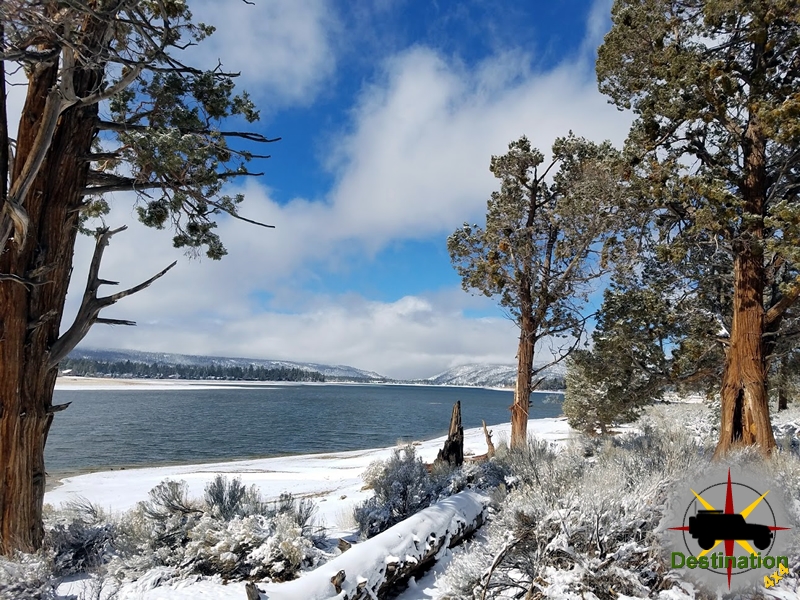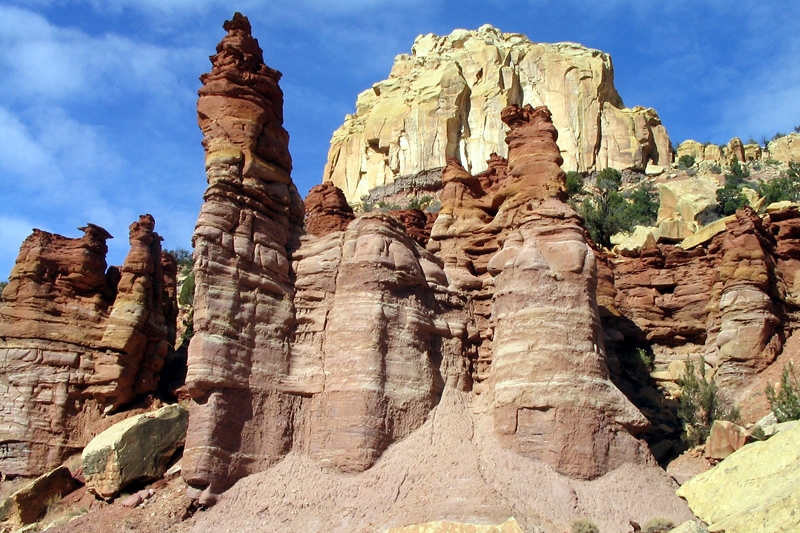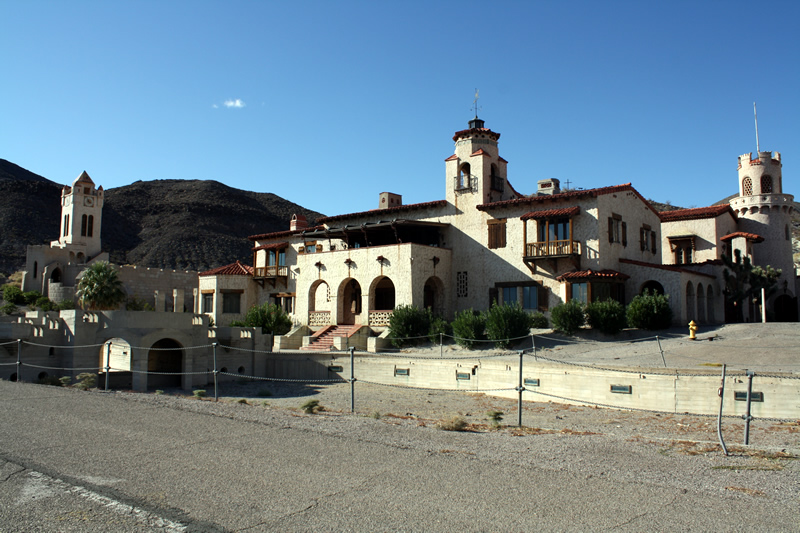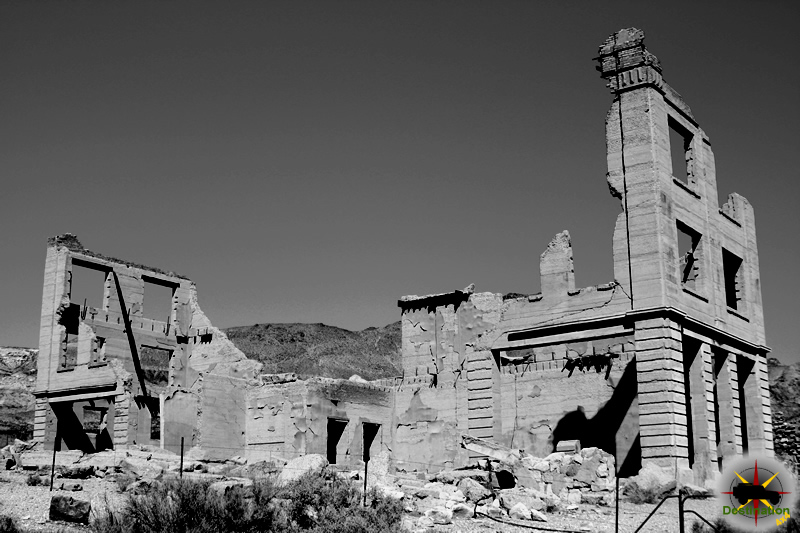
Overbury Building
The Overbury building is a general office building built by John Overbury, in Rhyolite, Nye County Nevada in 1906. The building was one of two three story buildings, and the largest stone building located within Rhyolite. The location of the building in about one block from the better known and more photographic Cook Bank Building.

John Overbury, a native of Orange, New Jersey, came to Nevada in 1902 and made his fortune in the early days of the Tonopah Mining boom. Like many of this peers, he came to Rhyolite hopping to be a part of the new. big boom. Local newspapers chronicled Overbury’s arrival in “a small Oldsmobile.” The next spring, he ordered a second Oldsmobile, and per the Rhyolite Herald, drove author Jack London down from Goldfield and our to Death Valley.
Construction of the Overbury building began in 1906; it was complete in June 1907. The structure was 45 feet wide by 80 feet long and cost somewhere between $45,000 – $60,000 to build.
The building was meant to be two stories tall; however, after John Cook began constructing a three-story building, Overbury quickly changed his mind and his building became three stories tall.
The Overbury Building was one the the first general purpose buildings in Rhyolite and the largest stone building. As one of the more prominent commercial hubs in town, it was fully equipped with fireproof shutters, an automatic sire suppression system, and private bathrooms.
At its height, the building housed a stock brokerage firm, the First National Bank of Rhyolite, a dentist, and attorney’s offices.
Like many of the other grand buildings in town, the Overbury Building was abandoned in 1910, and much of it was dismantled by 1924.
BLM Plaque, Rhyolite, Nevada
Overbury Building Map
References
Wild Burrow ( Equus africanus asinus )
The Wild Burro (Equus asinus), also known as the feral donkey or ass, is a resilient equid that has become a fixture in the harsh landscapes of the desert Southwest United States. Introduced by Spanish explorers in the 1500s and later released or escaped during the mining booms of the 19th century, these animals have adapted to arid environments where few large herbivores can survive. Often viewed as both an ecological challenge and a cultural icon, wild burros are managed by agencies like the Bureau of Land Management (BLM) and U.S. Forest Service due to their impacts on native vegetation and wildlife. With their sure-footed gait and ability to endure extreme conditions, they exemplify adaptation in one of North America’s most unforgiving regions.

Classification
The wild burro belongs to the kingdom Animalia, phylum Chordata, class Mammalia, order Perissodactyla (odd-toed ungulates), family Equidae, genus Equus, and species asinus. Native to North Africa, where it is known as the African wild ass, the species was domesticated thousands of years ago and introduced to the Americas. In the southwestern U.S., all populations are feral, descended from domestic stock released or escaped over centuries, and are classified as herbivores and non-native mammals. They share the Equidae family with horses and zebras, exhibiting similar social and grazing behaviors but with distinct adaptations for arid survival.
Physical Description
Wild burros are sturdy, medium-sized equids, standing approximately 4 to 5 feet (1.2 to 1.5 meters) tall at the shoulder and weighing around 350 pounds (159 kg), though sizes can vary. They have a robust build with long, erect ears (up to 10 inches or 25 cm) that aid in heat dissipation and hearing, a short, upright mane, and a tail ending in a tassel. Coat colors range from gray and brown to black, often with a lighter underbelly and muzzle, and a distinctive dark dorsal stripe or shoulder cross in some individuals. Their hooves are narrow and tough, suited for rocky terrain, and they possess a digestive system efficient at extracting nutrients from low-quality forage. Key adaptations include the ability to tolerate up to 30% body weight loss in water and replenish it quickly (in as little as 5 minutes), making them exceptionally suited to desert life.

Behavior
Wild burros are primarily diurnal, active during the day for foraging, but shift to nocturnal patterns in hot summers to avoid midday heat, resting in shade during peak temperatures. They form small, loose social groups of 2–10 individuals, often consisting of females and young with a dominant male, though home ranges overlap without strict territorial defense. Unlike wild horses, stable female bands are less common, and males may compete for access to females. They are sure-footed, navigating steep and rocky terrain with ease, and exhibit seasonal movements: concentrating near water and riparian areas in summer for shade and hydration, then dispersing to open shrublands in cooler months. Burros communicate through braying—a loud, distinctive “hee-haw”—and body language, and they can be curious toward humans but are generally wary. Their presence can impact ecosystems by altering vegetation and competing with native species like bighorn sheep for resources.
Food Sources
As herbivores, wild burros employ a mixed feeding strategy, acting as both grazers and browsers depending on availability. Their diet primarily consists of grasses and forbs when abundant, but they readily switch to browse such as shrubs, Mormon tea (Ephedra spp.), palo verde (Parkinsonia spp.), plantain, and other desert vegetation. This adaptability allows them to thrive on low-protein, fibrous plants, with their efficient digestive systems breaking down tough material. They require access to water but derive some moisture from succulent plants. In the Mojave and Sonoran Deserts, they consume a wide variety of species, contributing to their success in barren terrains but also leading to overgrazing concerns.
Breeding
Breeding in wild burros occurs year-round, with a peak in mating from May to July, aligning with optimal forage conditions. Gestation lasts about 12 months, resulting in births primarily from May to July the following year. Females (jennies) typically produce one precocial foal (colt or filly) per pregnancy, often every other year, though annual births are possible in favorable conditions. Foals are born weighing around 50–70 pounds (23–32 kg) and can stand and nurse shortly after birth. Sexual maturity is reached as yearlings, but full breeding often begins at 2–3 years. Recruitment rates hover at 20–25%, with low natural predation contributing to population growth. During parturition, females seek cover in brush or riparian areas. Lifespan in the wild can reach 25 years, aided by few diseases or predators.
Habitat and Range
Wild burros inhabit arid and semi-arid deserts, including sagebrush, creosote bush scrub, desert riparian zones, washes, Joshua tree woodlands, and pinyon-juniper areas, from below sea level to elevations up to 8,000 feet (2,450 meters). Key requirements include access to water within 10 miles (16 km), shade for thermoregulation, and diverse vegetation for foraging. They prefer sloping, rolling terrain over steep slopes and localize around water sources in summer, with home ranges varying from 2–22 square miles (5–70 km²) based on season and resources. Their range spans the desert Southwest, including California (e.g., Mojave Desert, Death Valley), Arizona, Nevada (e.g., near Austin), New Mexico, Utah, and parts of Texas, with populations estimated at around 20,000. Managed herds exist on public lands, with ongoing conservation efforts to balance their presence with ecosystem health.
Classification
| Kingdom: | Animalia |
| Phylum: | Chordata |
| Class: | Mammalia |
| Order: | Perissodactyla |
| Family: | Equidae |
| Genus: | Equus |
| Species: | E. africanus |
| Subspecies: | E. a. asinus |
References
Goldfield Nevada
Goldfield is Nevada State Historical Marker number fourteen and is located in Esmeralda County, Nevada. Goldfield was a boomtown between 1903 and 1940. Goldfield’s mines produced more than $86 million at then-current prices. Much of the town was destroyed by a fire in 1923, although several buildings survived and remain today, notably the Goldfield Hotel, the Consolidated Mines Building, the schoolhouse.

Goldfield was established in 1902 when gold was discovered in the surrounding hills. This discovery ignited a rush of prospectors, investors, and opportunists eager to capitalize on the newfound wealth. Unlike other mining towns in Nevada, which primarily focused on silver, Goldfield was notable for its rich gold deposits.
The town’s boom truly began in 1904 when the Consolidated Goldfield Company was formed, consolidating smaller claims and turning mining operations into a large-scale enterprise. By 1906, Goldfield’s population had swelled to over 20,000, making it Nevada’s largest city at the time.
During its heyday, Goldfield was a hub of wealth and activity. The mines produced an estimated $86 million in gold, a staggering amount for the era. The town boasted modern amenities, including electricity, telephones, and luxurious buildings such as the Goldfield Hotel, completed in 1908, which remains an iconic structure to this day.
The town also became a cultural center, hosting boxing matches, theatrical performances, and other events that attracted notable figures, including heavyweight champion Jack Johnson.
Goldfield’s prosperity was not without challenges. In 1907, the Panic of 1907 and declining ore quality began to affect mining profits. Labor disputes further disrupted operations, with a notable miners’ strike in 1907 escalating tensions between workers and mine owners.
A devastating fire in 1923 destroyed much of the town, including many of its iconic buildings. By this time, mining activity had significantly declined, and the town’s population dwindled as residents sought opportunities elsewhere.
Nevada State Historic Marker Text
Nevada State Historical Markers identify significant places of interest in Nevada’s history. The Nevada State Legislature started the program in 1967 to bring the state’s heritage to the public’s attention with on-site markers. Budget cuts to the program caused the program to become dormant in 2009. Many of the markers are lost of damaged.
For a 20-year period prior to 1900 the mining in Nevada fell into a slump that cast the entire state into a bleak depression and caused the loss of one-third of the population.
The picture brightened overnight following the spectacular strikes in Tonopah and, shortly afterwards, in Goldfield. Gold ore was discovered here in December, 1902, by two Nevada-born prospectors, Harry Stimler and Billy Marsh. From 1904 to 1918 Goldfield boomed furiously. The city had a railroad that connected into Las Vegas and a peak population of 20,000. Between 1903- 40 a total of $86,765,044 in metals was produced here.
Neada State Historic Marker #14
Summary
| ID | 14 |
| Name | Goldfield Nevada State Historic Marker |
| Location | Esmeralda County, Nevada |
| Latitude, Longitude | 37.7076, -117.2335 |

Telegraph Company Building is located in Goldfield, Nevada and Nevada State Historic Marker #242. Photo by James L Rathbun



Points of Interest
 Bullfrog Goldfield RailroadThe Bullfrog and Goldfield Railroad, often referred to as the B&G Railroad, played a significant role in the late 19th and early 20th-century mining boom… |
 Esmeralda County CourthouseThe court house in Goldfield, Nevada is the Esmeralda County Courthouse and Nevada State Historic Marker #80. Photo by James L Rathbun The Esmeralda County… |
 Goldfield Fire StationThe Goldfield Historic Fire Station, located in Goldfield, Nevada, is a significant historical structure that stands as a testament to the town's vibrant past during… |
 Goldfield NevadaGoldfield is Nevada State Historical Marker number fourteen and is located in Esmeralda County, Nevada. Goldfield was a boomtown between 1903 and 1940. Goldfield's mines produced… |
 The Goldfield HotelThe Goldfield Hotel located in Goldfield Nevada. Photo by James L Rathbun The Goldfield Hotel, located at the southeast corner of Crook Avenue (U.S. Route… |
References
Culverwells Ranch
Culverwells Ranch is Nevada State Historical Marker number fifty five located in Lincoln county, Nevada.
The meadow area around the junction of Meadow Valley Wash and Clover Creek was originally settled in the early 1860’s by Ike and Dow Barton, two Negro slaves who had escaped from Arkansas. In the early 1870’s the area was known as Dutch Flat. In 1874, ranchers Charles and William Culverwell purchased the Jackman Ranch and renamed it as Culverwell Ranch. It was later referred to as “Culverwell.” Along with ranching, the family earned a living by providing hay for the mining camps in Pioche and Delamar.
A dispute between two major railroad companies began when E.H. Harriman of the Oregon Short Line and Union Pacific, pushed track from Utah to the site of Culverwell. Even as Harriman’s crews worked on the line, the newly formed San Pedro, Los Angeles and Salt Lake Railroad owned by Senator William Clark, claimed the same territory. These rival groups had sought the right-of-way in a canyon only big enough only for a single set of tracks. The Union Pacific had grade stakes set all the way into Culverwell and on toward Pioche, but their rival group gobbled up enough of the narrow canyon to set a road block in the path of Union Pacific
Nevada State Historical Markers identify significant places of interest in Nevada’s history. The Nevada State Legislature started the program in 1967 to bring the state’s heritage to the public’s attention with on-site markers. Budget cuts to the program caused the program to become dormant in 2009. Many of the markers are lost of damaged.
Marker Text
Caliente was first settled as a ranch, furnishing hay for the mining camps of Pioche and Delmar. In 1901, the famous Harriman-Clark right-of-way battle was ended when rancher Charles Culverwell, with the aid of a broad-gauge shotgun, allowed one railroad grade to be built through his lush meadows. Harriman and Clark had been baffling eleven years, building side-by-side grades ignoring court orders and federal marshals.
The population boom began with an influx of railroad workers, most of them immigrants from Austria, Japan, and the Ottoman Empire. A tent city was settled in August 1903.With the completion of the Las Angeles, San Pedro, and Salt Lake Railroad in 1905, Caliente became a division point. Beginning in 1906, the Caliente and Pioche Railroad (now the Union Pacific) was built between Pioche and the main line at Caliente. The large Mission Revival-style depot was built in 1923, serving as a civic center, as well as a hotel.
STATE HISTORICAL MARKER No. 55
STATE HISTORIC PRESERVATION OFFICE
LINCOLN COUNTY AREA DEVELOPMENT COMMITTEE
Summary
| Nevada State Historic Marker | 55 |
| Name | Culverwell’s Ranch |
| Location | Lincoln County, Nevada |
| Latitude, Longitude | 37.6133, -114.5148 |
Nevada State Historic Marker #55 Map
References
Artist Drive
Artist Drive is perhaps one of the most popular and scenic drives through a colorful palette of geology, located in Death Valley National Park, California. Artist drive is a one way road about nine miles long which takes just about two hour to complete provided you take the time to hike a few of the short trails. The road is a popular destination for hikers and bikers as well as motor vehicles. From the drivers perspective, the road can be quite fun to drive and it twists and turns up and down the colorful hillside.

The hills which contain burst of color were formed by volcanic deposits of different compounds such as iron oxides and chlorite, which creates a rainbow effect of color. There is no bad time to visit, however, the photographer will appreciate the warm afternoon sunlight enhancing the natural colors in the soil. The best features are on a westward facing slope which really benefits from the late hours in the day.
While the colors of the location are amazing, do not forget to turn around the allow the scenic vistas of Death Valley to take your breath away. On a visit during a three day weekend in February 2022, I was surprised by the volume of people on the route. All of the parking lanes were full and it became quite difficult photographically due to the visitors. I will say, that during this time the COVID pandemic was relaxing and it was really nice seeing people enjoying themselves outside.
Prior to becoming a National Park, Assist’s Drive and some of the nearby valley’s were a filming location for the movie Star Wars.




